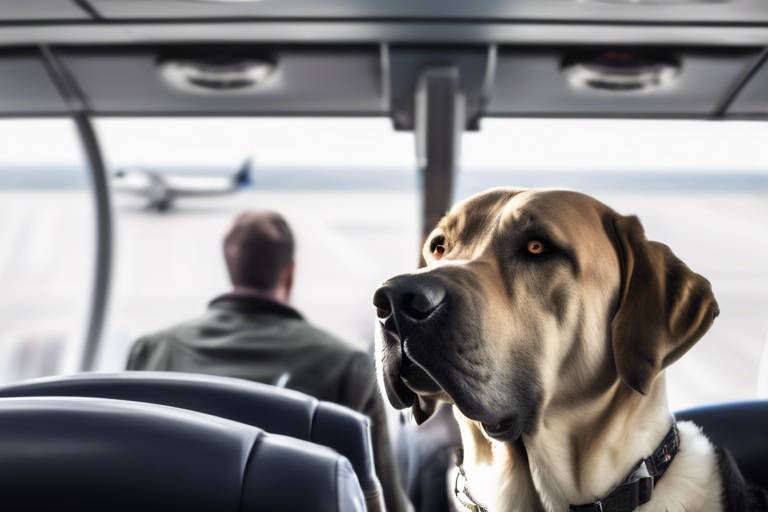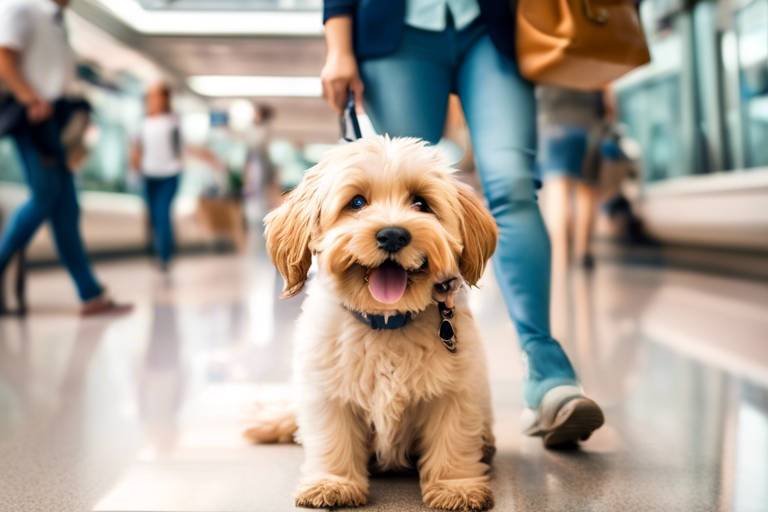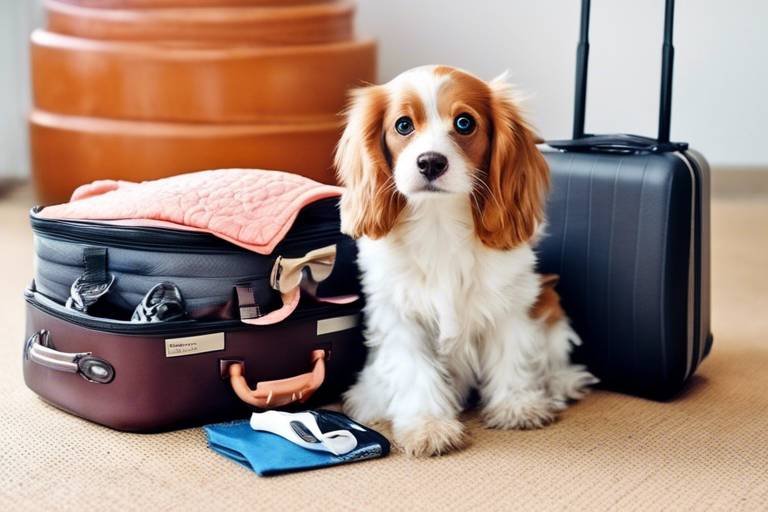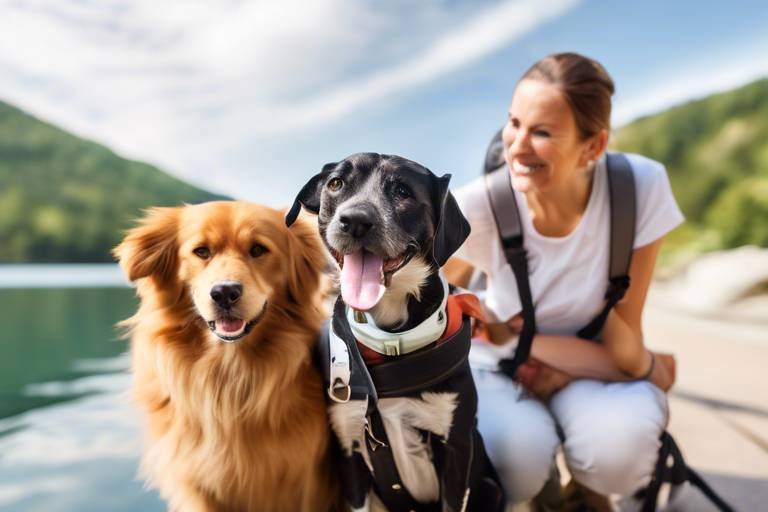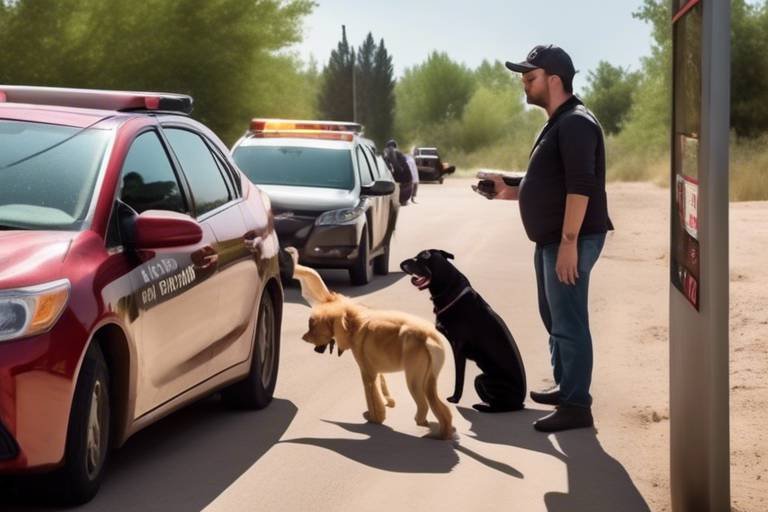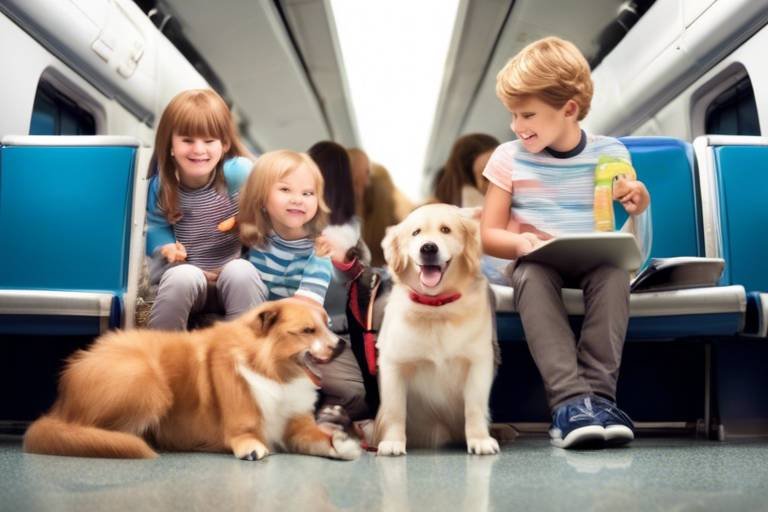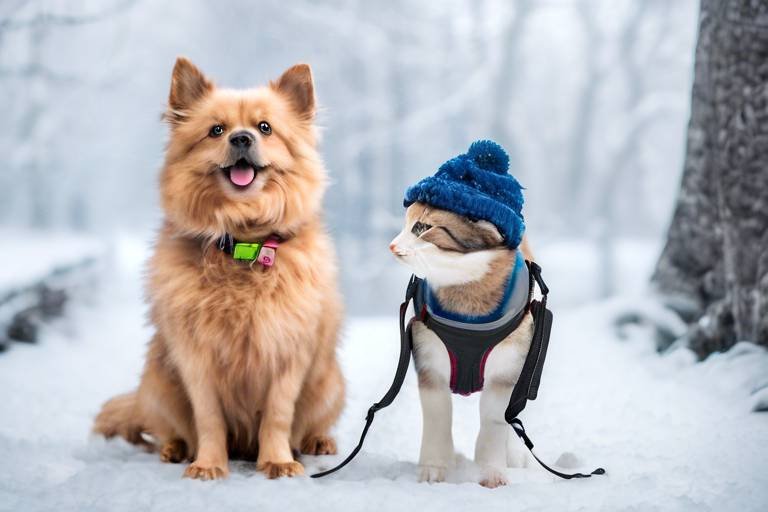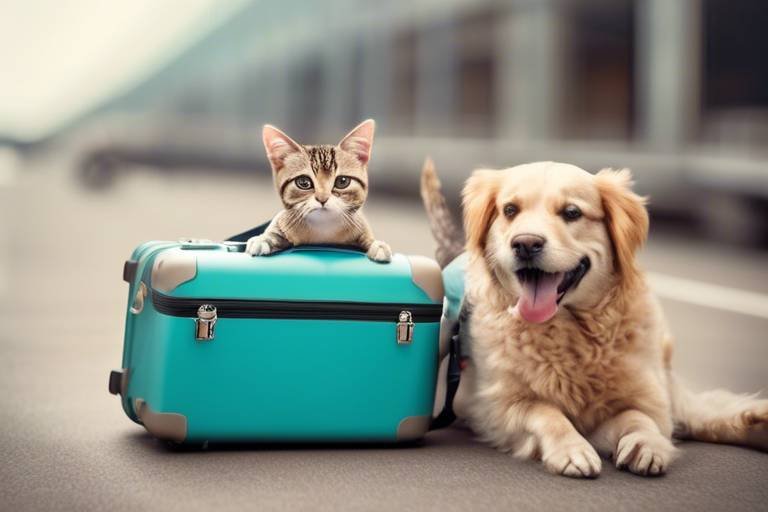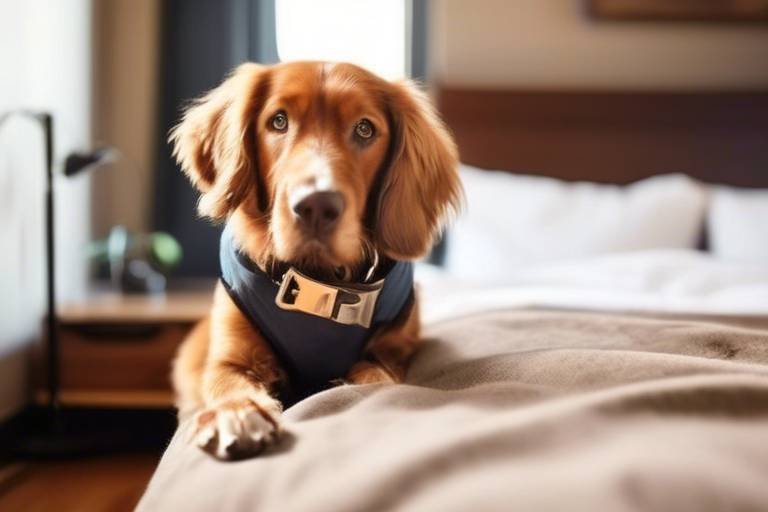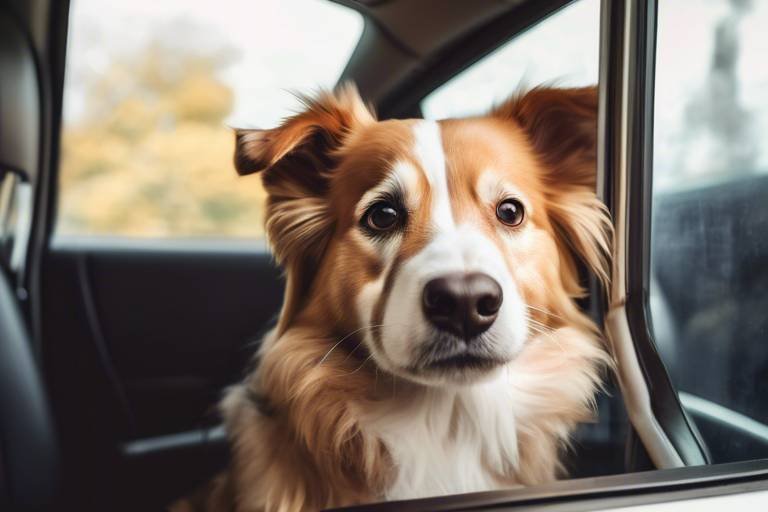Tips for Flying with Large Dogs
Traveling with your furry friend can be an exciting adventure, but when it comes to large dogs, there are some unique challenges to consider. Whether you’re heading to a new home, visiting family, or taking a vacation, ensuring a safe and comfortable journey for both you and your dog is essential. Flying can be stressful for pets, especially larger breeds, but with the right preparation and knowledge, you can make the experience as smooth as possible. In this article, we’ll explore crucial tips and guidelines that will help you navigate the skies with your large dog, ensuring that both of you arrive at your destination ready to enjoy your time together.
Not all airlines treat our four-legged companions the same way. Some are more pet-friendly than others, especially when it comes to accommodating large dogs. It’s vital to do your homework before booking a flight. Look for airlines that have specific policies tailored for larger breeds. You’ll want to consider factors like:
- Pet Policy: Does the airline allow large dogs in the cabin, or will they need to travel in the cargo hold?
- Crate Requirements: Are there specific crate dimensions and types that the airline mandates?
- Fees: What are the costs associated with flying your dog?
- Travel Conditions: How does the airline ensure the safety and comfort of pets traveling in cargo?
By carefully selecting an airline that aligns with your needs, you can significantly reduce travel-related stress for both you and your pup.
Proper preparation can alleviate stress for both you and your dog. This section covers essential steps to take before your flight, including health checks and necessary documentation. The more prepared you are, the smoother your travel will be, and your dog will be more at ease.
Many airlines require specific health documentation for pets. Understanding these requirements can help prevent any last-minute issues at the airport. It’s crucial to familiarize yourself with the health regulations of both the airline and your destination. This includes vaccination records and any health certifications that may be required.
Scheduling a thorough veterinary examination is vital to ensure your dog is fit for travel and up-to-date on vaccinations. A good vet will assess your dog’s health and provide guidance on any additional precautions you may need to consider, especially if your dog has existing health conditions.
Obtaining a health certificate signed by a veterinarian may be necessary for air travel. This document confirms your dog’s health status and vaccination history. Make sure to get this certificate within the required timeframe set by the airline, as some may only accept certificates issued within a certain number of days prior to travel.
Choosing the right travel crate is essential for your dog's safety and comfort during the flight. Look for a crate that meets the airline's specifications and is large enough for your dog to stand, turn around, and lie down comfortably. Additionally, consider features such as:
- Ventilation: Ensure the crate has adequate ventilation to keep your dog cool and comfortable.
- Durability: A sturdy crate will keep your dog safe during transit.
- Familiarity: Introducing your dog to the crate before the trip can help reduce anxiety.
The day of travel can be hectic. This section offers practical tips to keep your large dog calm and comfortable while navigating the airport. Starting your day with a plan can make a world of difference.
Knowing when to feed and hydrate your dog before the flight can prevent discomfort and anxiety. It’s generally best to feed your dog a light meal a few hours before the flight to avoid nausea. Make sure to provide plenty of water, but try to limit drinking right before boarding to reduce the need for bathroom breaks during the flight.
Giving your dog ample exercise before the flight can help reduce their energy levels and anxiety. A long walk or play session can tire them out, making them more likely to relax during the journey. Think of it as a pre-flight workout—just like you would do before a long trip!
After arriving at your destination, there are important steps to take to ensure your dog's well-being. Helping your dog adjust to new surroundings is crucial for their comfort. Allow your dog some time to explore and sniff their new environment, which can be incredibly comforting. You might also want to keep their routine as normal as possible, including feeding times and walks, to help them settle in.
Q: Can I bring my large dog in the cabin with me?
A: Most airlines do not allow large dogs in the cabin, and they typically must travel in the cargo hold. Always check with the airline for their specific policies.
Q: What if my dog has anxiety about flying?
A: Consult your veterinarian for advice on calming medications or strategies to help ease your dog's anxiety during travel.
Q: How do I ensure my dog is comfortable in the crate?
A: Make sure the crate is familiar to your dog by allowing them to spend time in it before the trip. Adding their favorite blanket or toy can also help.
By following these tips and guidelines, you can ensure a smooth travel experience for both you and your large dog. Safe travels!

Choosing the Right Airline
When it comes to flying with your large dog, selecting the right airline is absolutely crucial. Not all airlines are created equal, and their pet policies can vary significantly. This means that what works for one pet owner might not work for another. So, how do you ensure that your furry friend has a comfortable and safe journey? Start by researching airlines that specifically accommodate large dogs. Look for those with a good reputation for pet travel, as well as policies that are transparent and easy to understand.
Consider checking the following factors when choosing an airline:
- Pet Policies: Review the airline’s specific rules regarding large dogs. Some airlines may only allow pets in the cabin if they meet certain weight restrictions, while others might require larger dogs to travel in the cargo hold.
- Travel Crate Requirements: Make sure the airline has guidelines for the type of crate you’ll need. It should be well-ventilated, secure, and spacious enough for your dog to stand, turn around, and lie down comfortably.
- Fees and Costs: Understand the fees associated with traveling with your dog. Some airlines may charge extra for pet travel, so be sure to factor this into your overall travel budget.
- Customer Reviews: Look up reviews from other pet owners who have flown with their large dogs. Their experiences can provide valuable insights into which airlines are pet-friendly and which ones to avoid.
Additionally, it’s wise to contact the airline directly for any specific questions or concerns. Sometimes, speaking to a representative can clarify policies and help you understand the best options for your dog. Don’t hesitate to ask about their experience with large dogs, as well as any tips they might have for ensuring a smooth travel experience.
Once you've narrowed down your choices, consider booking your flight during less busy travel times. This can mean flying mid-week or during off-peak seasons, which may lead to a more relaxed atmosphere both for you and your dog. Remember, a calm environment can significantly reduce your dog's anxiety levels and make the journey more enjoyable.
In summary, choosing the right airline is about more than just price; it’s about ensuring that your large dog is well cared for during the flight. By doing your homework and selecting an airline that prioritizes pet comfort and safety, you can embark on your journey with confidence, knowing that your furry companion will be in good hands.

Preparation for Travel
When it comes to flying with your large dog, preparation is key. The more organized you are before your journey, the smoother the experience will be for both you and your furry friend. Start by ensuring that you have all the necessary documentation and health checks completed well in advance. This will not only help you avoid any last-minute hiccups but will also give you peace of mind, knowing that your dog is ready for the adventure ahead.
One of the first steps in your preparation should be to schedule a veterinary check-up. This visit is crucial as it allows you to confirm that your dog is in good health and up-to-date on vaccinations. Many airlines require specific vaccinations, and having your vet’s approval can save you from potential issues at the airport. During this check-up, ask your veterinarian about any medications your dog might need for anxiety during the flight. Some dogs may benefit from calming supplements or medications, especially if they are not used to traveling.
Once your dog has been cleared for travel, it's time to obtain a health certificate. This document, typically issued by your veterinarian, confirms that your dog is healthy and has received all necessary vaccinations. Different airlines may have varying requirements regarding health certificates, so be sure to check the specific regulations of the airline you’ll be flying with. It’s advisable to have multiple copies of this certificate on hand, just in case you need to present it at different checkpoints.
In addition to health documentation, you’ll also need to focus on selecting the right travel crate for your dog. This is where your dog will spend a significant amount of time during the flight, so it should be both comfortable and secure. Look for a crate that meets the International Air Transport Association (IATA) guidelines. The crate should be well-ventilated, spacious enough for your dog to stand, turn around, and lie down comfortably. Also, consider adding familiar items like a blanket or a favorite toy to help your dog feel more at ease.
Finally, don’t forget to prepare for the unexpected. Traveling can be unpredictable, and having a plan in place for emergencies can make a world of difference. Pack a travel bag with essentials such as food, water, a leash, waste bags, and any medications your dog might need. Having these items readily available can help you manage any situation that arises during your journey.
In summary, the preparation phase is all about ensuring that your large dog is healthy, comfortable, and secure for the journey ahead. By taking the time to check off each of these important steps, you’ll not only make the travel experience better for your dog but also enjoy a more relaxed and enjoyable trip.
Q: What documents do I need to travel with my large dog?
A: You will typically need a health certificate from your veterinarian and proof of vaccinations. Check with your airline for specific requirements.
Q: How can I help my dog feel comfortable in a travel crate?
A: Use a crate that is spacious and well-ventilated. Add familiar items like a blanket or toy, and consider practicing short stays in the crate before your trip.
Q: What should I do if my dog experiences anxiety during the flight?
A: Consult your veterinarian for advice on calming medications or supplements. Additionally, try to keep your dog’s routine as normal as possible leading up to the trip.
Health Requirements
When it comes to flying with your large dog, understanding the set by airlines is crucial. Every airline has its own set of rules regarding pet travel, and many require specific health documentation to ensure the safety and well-being of all passengers, including your furry friend. Before you even think about booking that flight, it’s essential to do your homework on what health checks and documents are needed. This can save you from unexpected surprises at the airport that could delay your travel plans.
First and foremost, most airlines will ask for a veterinary health certificate. This document is issued by a licensed veterinarian and provides proof that your dog is healthy enough to travel. It typically includes information about your dog’s breed, age, and vaccination status. Some airlines require this certificate to be issued within a specific timeframe before travel—usually within 10 days. So, it’s a good idea to schedule a vet appointment well in advance of your trip.
Additionally, you’ll want to ensure that your dog is up-to-date on vaccinations, especially those that are commonly required for air travel. These may include rabies, distemper, and parvovirus vaccinations. If you’re unsure about your dog’s vaccination history, it’s best to consult your veterinarian. They can provide you with a complete vaccination record, which is often requested by airlines.
To make it easier for you to stay organized, here’s a quick overview of what you should prepare:
- Veterinary Health Certificate: Ensure it’s dated within the airline’s required timeframe.
- Vaccination Records: Keep a copy of your dog’s vaccination history handy.
- Microchip Information: While not always required, having your dog microchipped can be beneficial.
Lastly, it’s wise to double-check if your destination has any specific health requirements or quarantine regulations for pets. Some countries or states may have additional rules that you need to comply with before your arrival. By being proactive and gathering all necessary documents, you can help ensure a smooth travel experience for both you and your large dog.
Q: What is a veterinary health certificate, and why do I need it?
A: A veterinary health certificate is an official document from a licensed veterinarian that confirms your dog's health status and vaccination records. Airlines often require this to ensure that pets are fit for travel and to prevent the spread of diseases.
Q: How long before my flight should I get my dog's health certificate?
A: Most airlines require the health certificate to be issued within 10 days of travel. It’s best to schedule a vet appointment as close to your departure date as possible while still allowing time for any necessary vaccinations.
Q: Are there specific vaccinations my dog needs before flying?
A: Common vaccinations required for air travel include rabies, distemper, and parvovirus. However, it’s always best to check with your airline for their specific requirements.
Q: Do I need to microchip my dog before traveling?
A: While not always mandatory, microchipping your dog can be a good safety measure. It helps ensure that you can be reunited with your pet in case they get lost during your travels.
Veterinary Check-Up
When it comes to preparing for air travel with your large dog, a thorough is not just a good idea; it's essential. Think of this step as a pre-flight safety inspection for your furry friend. You wouldn’t board a plane without ensuring everything is in order, right? Similarly, your dog deserves the same level of care and attention. During the check-up, your veterinarian will assess your dog's overall health, checking for any underlying conditions that might complicate travel. This is particularly important for large breeds, as they can sometimes be more susceptible to certain health issues.
During the examination, the vet will typically check:
- Weight and Body Condition: Ensuring your dog is at a healthy weight can help prevent complications during travel.
- Vaccination Status: Confirming that your dog is up-to-date on all necessary vaccinations is crucial, especially since many airlines require proof.
- Heart and Lungs: A thorough check of your dog's heart and lungs can help detect any issues that may arise during the stress of travel.
It's also a great time to discuss any concerns you may have about your dog's behavior during travel. Does your dog get anxious in new environments? Does he or she have a history of motion sickness? Your vet can provide valuable advice and, if necessary, prescribe medications to help calm your dog during the flight. This proactive approach can make all the difference in ensuring a smooth journey.
Moreover, don’t forget to ask about the airline’s specific health requirements. Some airlines have particular guidelines regarding vaccinations or health checks that must be fulfilled prior to travel. This information is vital to avoid any last-minute surprises at the airport. So, make sure to jot down these requirements and confirm that your dog meets them before you pack your bags.
In summary, scheduling a veterinary check-up is a crucial step in preparing for air travel with your large dog. It not only ensures that your pet is healthy enough to fly but also provides peace of mind for you as an owner. After all, a well-prepared traveler is a happy traveler!
Health Certificates
When it comes to flying with your large dog, obtaining a health certificate is not just a formality; it’s a crucial step in ensuring a smooth journey. This document, typically issued by a licensed veterinarian, serves as proof that your dog is in good health and up-to-date on all required vaccinations. Airlines and even some states have specific health requirements that must be met before your furry friend can board the plane. So, what exactly does this mean for you as a pet owner?
Firstly, it's essential to schedule an appointment with your vet well in advance of your travel date. This way, you can ensure that your dog receives a thorough examination and any necessary vaccinations in a timely manner. Most airlines require that the health certificate be issued within a certain timeframe before travel—often within 10 days—so planning ahead is key to avoiding any last-minute scrambles.
During the vet visit, the veterinarian will assess your dog's overall health, checking for any signs of illness or discomfort. They will also verify that your dog is up-to-date on vaccinations, which may include rabies, distemper, and parvovirus, among others. If your dog has any pre-existing conditions or requires special care, make sure to discuss these with your vet, as they may need to be noted on the health certificate.
Once your dog is deemed fit for travel, your veterinarian will fill out the health certificate, which typically includes:
- Your dog's name and description
- Vaccination history
- Any medications or treatments your dog is currently receiving
- The veterinarian's contact information
- The date of the examination
It’s also a good idea to keep a copy of the health certificate for your records. You never know when you might need to present it again, whether it’s for a hotel stay, a different airline, or even a visit to a new vet in your destination city. Remember, having all the necessary documentation at your fingertips can save you from unexpected headaches and ensure your large dog has a safe and enjoyable travel experience.
In summary, obtaining a health certificate for your large dog is an essential step in preparing for air travel. By ensuring your dog is healthy and vaccinated, you not only comply with airline regulations but also contribute to the overall well-being of your pet during the journey. So, take the time to get this important document sorted out, and you’ll have one less thing to worry about as you embark on your adventure together!
Here are some common questions pet owners have about health certificates for flying with large dogs:
- Do all airlines require a health certificate? Yes, most airlines have specific health requirements, including a health certificate, to ensure the safety and well-being of all pets on board.
- How long is a health certificate valid? Typically, health certificates are valid for 10 days from the date of issuance, but it's best to check with your airline for their specific policies.
- What if my dog has special health needs? If your dog requires special care or has pre-existing conditions, discuss these with your veterinarian, as they can be included in the health certificate.
- Can I travel without a health certificate? Traveling without a health certificate can lead to denied boarding or delays, so it’s essential to have this document prepared.
Travel Crate Selection
This article provides essential tips and guidelines for pet owners traveling with large dogs by air, ensuring a safe and comfortable journey for both the pet and its owner.
Not all airlines have the same policies for flying with pets. Researching and selecting an airline that accommodates large dogs is crucial for a smooth travel experience.
Proper preparation can alleviate stress for both you and your dog. This section covers essential steps to take before your flight, including health checks and necessary documentation.
Many airlines require specific health documentation for pets. Understanding these requirements can help prevent any last-minute issues at the airport.
Scheduling a thorough veterinary examination is vital to ensure your dog is fit for travel and up-to-date on vaccinations.
Obtaining a health certificate signed by a veterinarian may be necessary for air travel. This document confirms your dog’s health status and vaccination history.
Choosing the right travel crate is essential for your dog's safety and comfort during the flight. Think of the crate as your dog’s home away from home; it should be a cozy, secure space that makes them feel safe. When selecting a crate, consider the following features:
- Size: Your dog should be able to stand up, turn around, and lie down comfortably. Measure your dog from nose to tail and shoulder height to find the right size.
- Material: Opt for a durable, well-ventilated crate made from sturdy materials. Plastic and metal crates are popular choices, as they provide both safety and comfort.
- Ventilation: Ensure the crate has adequate ventilation to keep your dog cool and comfortable during the flight. Look for crates with multiple ventilation openings.
- Security: Check that the crate has secure latches and locks to prevent accidental escapes. A well-designed crate will keep your furry friend safe and sound.
Additionally, it’s a good idea to familiarize your dog with the crate before the trip. This can help reduce anxiety and make them feel more comfortable. You might want to place their favorite blanket or toy inside to create a sense of familiarity. Remember, the crate is not just a travel necessity; it can also be a comforting space for your dog.
The day of travel can be hectic. This section offers practical tips to keep your large dog calm and comfortable while navigating the airport.
Knowing when to feed and hydrate your dog before the flight can prevent discomfort and anxiety. Learn the best practices for managing your dog's meals.
Giving your dog ample exercise before the flight can help reduce their energy levels and anxiety. Discover effective ways to tire them out before travel.
After arriving at your destination, there are important steps to take to ensure your dog's well-being. This section discusses how to help your dog adjust to new surroundings.
Q: Can I take my large dog in the cabin with me?
A: Most airlines do not allow large dogs in the cabin; they typically require them to be transported in the cargo hold. However, checking with your specific airline is essential as policies can vary.
Q: What should I do if my dog is anxious about flying?
A: To help ease your dog's anxiety, consider using calming aids, familiar toys, and ensuring they have ample exercise before the flight. Training them to feel comfortable in the crate beforehand can also help.
Q: How early should I arrive at the airport with my dog?
A: It’s advisable to arrive at least 2-3 hours before your flight to allow time for check-in, security, and to give your dog a chance to acclimate to the busy airport environment.
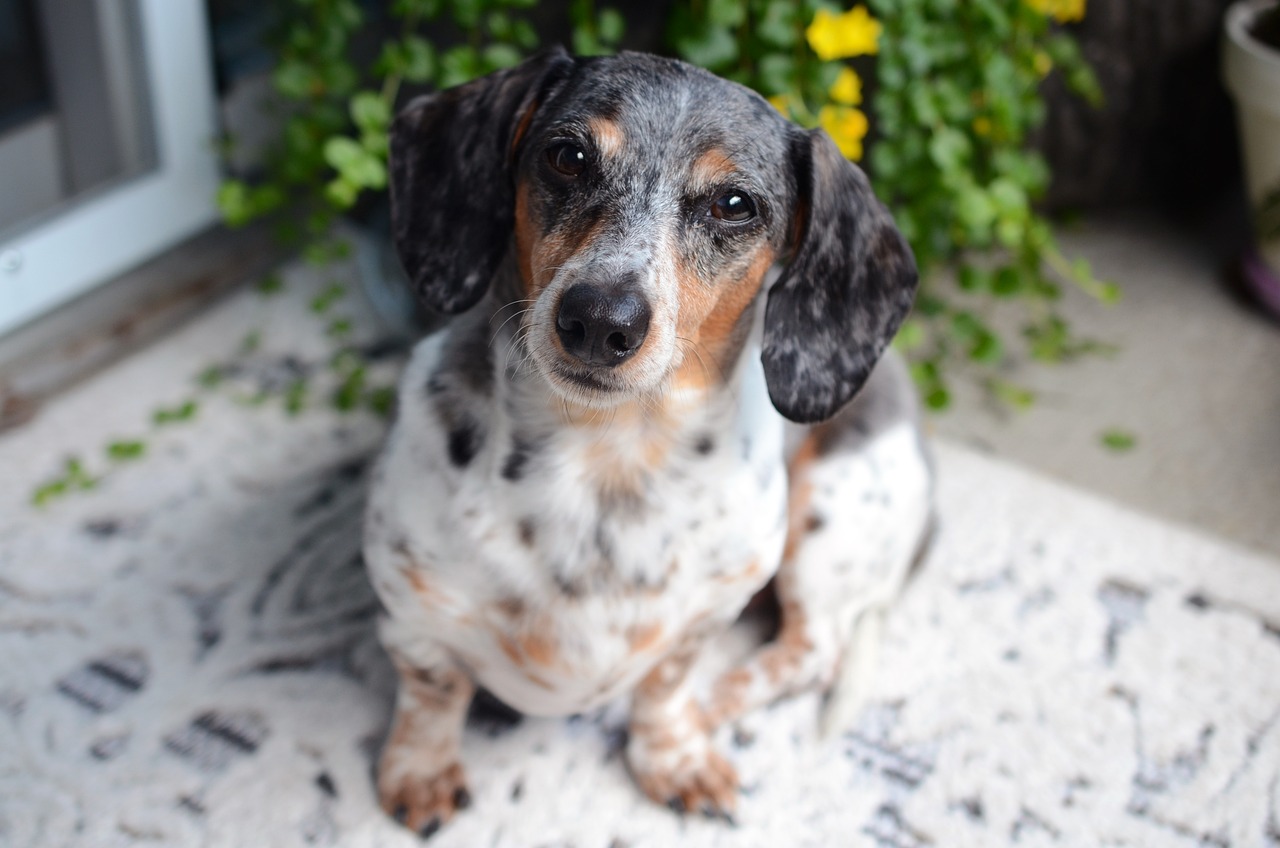
Day of Travel Tips
The day of travel can be a whirlwind of excitement and anxiety, not just for you but for your beloved large dog as well. To ensure a smooth experience, it’s essential to plan ahead and keep a few key strategies in mind. First and foremost, consider your dog's needs throughout the day, from their last meal to bathroom breaks. A well-prepared owner makes for a happy pet!
One of the most critical aspects of travel is feeding and hydration. You want to avoid feeding your dog right before the flight to prevent any potential nausea or discomfort. Aim to feed your dog about 4-6 hours before your departure. This way, they have enough time to digest their meal and relieve themselves before heading to the airport. Additionally, provide fresh water throughout the day, but limit their intake an hour before the flight to avoid frequent bathroom breaks during travel.
Next, let’s talk about exercise before departure. Just like us, dogs can get anxious when cooped up for too long. A vigorous walk or play session can help burn off excess energy and calm their nerves. Think of it as a pre-flight workout! Not only will this help tire them out, but it also gives them an opportunity to relieve themselves before the trip. Consider a visit to a nearby dog park or a long stroll around your neighborhood. The goal is to make sure they are ready to relax during the flight.
As you prepare to leave for the airport, don’t forget to pack a travel essentials bag for your dog. This bag should include items like their favorite toy, a blanket, and any medications they may need. Familiar items can provide comfort in a stressful environment. Additionally, be sure to have a leash handy for when you arrive at the airport and need to navigate through the terminals. Remember, your dog is picking up on your energy, so staying calm and collected will help them feel more secure.
When you arrive at the airport, give yourself plenty of time to check in and navigate security. Airports can be overwhelming for dogs, with all the sounds and sights. If possible, take your dog for a short walk around the terminal before boarding. This will allow them to stretch their legs and relieve themselves one last time. Also, keep an eye on the time, so you’re not rushing and adding to your dog’s stress.
Lastly, remember that your dog will likely be in their crate during the flight. Make it as comfortable as possible by placing familiar items inside, like a blanket or a favorite toy. This will help ease their anxiety and make the journey more pleasant. After all, a comfortable dog is a happy dog!
By following these day-of-travel tips, you can ensure that both you and your large dog have a safe and enjoyable flying experience. With the right preparation and mindset, you can turn what could be a stressful day into a smooth adventure.
- What should I do if my dog gets anxious during the flight?
Consider speaking with your veterinarian about calming aids or techniques to help soothe your pet. - Can I bring my dog in the cabin with me?
Most airlines have specific policies regarding pets in the cabin, so check with your chosen airline before booking. - How do I ensure my dog is comfortable in their crate?
Make sure the crate is well-ventilated, and add familiar items like blankets or toys to create a cozy environment.
Feeding and Hydration
This article provides essential tips and guidelines for pet owners traveling with large dogs by air, ensuring a safe and comfortable journey for both the pet and its owner.
Not all airlines have the same policies for flying with pets. Researching and selecting an airline that accommodates large dogs is crucial for a smooth travel experience.
Proper preparation can alleviate stress for both you and your dog. This section covers essential steps to take before your flight, including health checks and necessary documentation.
Many airlines require specific health documentation for pets. Understanding these requirements can help prevent any last-minute issues at the airport.
Scheduling a thorough veterinary examination is vital to ensure your dog is fit for travel and up-to-date on vaccinations.
Obtaining a health certificate signed by a veterinarian may be necessary for air travel. This document confirms your dog’s health status and vaccination history.
Choosing the right travel crate is essential for your dog's safety and comfort during the flight. Learn about the features to look for in a suitable crate.
The day of travel can be hectic. This section offers practical tips to keep your large dog calm and comfortable while navigating the airport.
When it comes to flying with your large dog, play a pivotal role in ensuring a smooth journey. Timing is everything! Ideally, you should feed your dog a few hours before the flight. This allows enough time for digestion and helps prevent any potential accidents in the crate. However, you don’t want to leave your furry friend hungry or thirsty either. A good rule of thumb is to provide a light meal, and then withhold food for about 4-6 hours prior to departure.
Hydration is equally important. Make sure your dog has access to fresh water before leaving home. You can also consider using a spill-proof water bowl, which can be a lifesaver during travel. Remember, though, that you should limit water intake right before the flight to avoid any discomfort during the journey. A little trick is to carry a portable water bottle specifically designed for dogs, making it easy to offer them a sip during layovers or before boarding.
In case your flight is long, and you are concerned about your dog's hydration, check with the airline about their policies on providing water during the flight. Some airlines may allow you to give your dog water during layovers, while others might have restrictions. If you’re unsure, it’s always a good idea to call ahead and clarify.
To make it easier for you, here’s a quick summary of feeding and hydration tips:
- Feed your dog a light meal about 4-6 hours before the flight.
- Provide access to fresh water before you leave home.
- Consider a spill-proof water bowl for travel.
- Limit water intake right before the flight.
- Check airline policies regarding hydration during the flight.
Giving your dog ample exercise before the flight can help reduce their energy levels and anxiety. Discover effective ways to tire them out before travel.
After arriving at your destination, there are important steps to take to ensure your dog's well-being. This section discusses how to help your dog adjust to new surroundings.
Q: Can I feed my dog right before the flight?
A: It's best to feed your dog a few hours before the flight to allow for digestion and to avoid accidents in the crate.
Q: What should I do if my dog refuses to drink water during travel?
A: Offer water during layovers and try using a portable water bottle designed for dogs. If they still refuse, don’t worry too much; just ensure they are hydrated before the trip.
Q: Are there specific airlines that are better for flying with large dogs?
A: Yes, some airlines have more accommodating policies for large dogs. It’s essential to do your research to find one that suits your needs.
Exercise Before Departure
Traveling with a large dog can be a thrilling adventure, but it can also be a bit daunting, especially when it comes to ensuring your furry friend is calm and collected during the journey. One of the best ways to achieve this is by giving your dog ample exercise before you head to the airport. Think of it as a pre-flight workout; just like humans, dogs benefit from burning off extra energy, which can lead to a more relaxed and quiet travel experience.
So, how do you tire out your pup before the big trip? Here are some effective strategies:
- Long Walks: Take your dog on a brisk, extended walk around your neighborhood or a nearby park. Aim for at least 30 minutes to an hour, depending on your dog's stamina and breed.
- Play Fetch: If you have access to a yard or an open space, engage your dog in a game of fetch. This not only exercises them but also strengthens your bond.
- Interactive Toys: Use puzzle toys or treat-dispensing balls to keep your dog mentally stimulated. This can be a great way to tire them out without needing a lot of space.
It’s important to remember that every dog is different. Some might need more vigorous exercise, while others may be content with a leisurely stroll. Pay attention to your dog's cues; if they seem tired, it’s time to wind down. Also, try to schedule this exercise session a few hours before your flight. This way, your pup will have time to cool down and relax before the chaos of the airport begins.
Additionally, don’t forget to bring along some familiar items, such as their favorite toy or blanket. These can provide comfort and a sense of security, helping to ease any travel anxiety they may feel. Just like us, dogs can become stressed in new environments, so anything that reminds them of home can be a lifesaver.
In summary, ensuring your large dog gets plenty of exercise before departure is a key step in making air travel a positive experience for both of you. By investing time in a solid workout, you’re not just helping your dog burn off excess energy; you’re also setting the stage for a smoother journey ahead.
Here are some common questions pet owners have when flying with large dogs:
- What should I do if my dog is anxious about flying? Consider consulting your vet about calming aids or medications that might help ease their anxiety.
- Can I take my dog in the cabin with me? This depends on the airline's policies regarding pet travel. Some allow large dogs in the cabin if they meet specific size requirements.
- How can I ensure my dog is comfortable in the crate? Make the crate a familiar space by allowing your dog to spend time in it before the trip. Include their favorite blanket or toy for added comfort.

Post-Arrival Considerations
After a long flight, your large dog may feel a bit disoriented and anxious in their new surroundings. It's crucial to help them adjust smoothly to their new environment. Start by giving them a moment to explore their temporary home. Dogs are naturally curious creatures, and allowing them to sniff around can significantly ease their anxiety. Just like humans, they need to familiarize themselves with their surroundings to feel secure.
One effective way to help your dog settle in is to create a designated space for them. This can be a cozy spot with their bed, toys, and some familiar items from home. Think of it as their little sanctuary amidst all the changes. It's important that they have a place to retreat to whenever they feel overwhelmed. Additionally, try to maintain a routine as much as possible. Dogs thrive on consistency, so sticking to their feeding and walking schedule can create a sense of normalcy.
Another vital aspect post-arrival is monitoring your dog's health and behavior. Keep an eye out for any signs of stress or discomfort, such as excessive barking, pacing, or reluctance to eat. If you notice anything unusual, it might be worth contacting a local veterinarian. Remember, just like humans, dogs can also experience travel-related stress, which can sometimes manifest in physical symptoms.
To ensure your dog has an enjoyable stay, consider the following tips:
- Hydration: Make sure your dog has access to fresh water at all times. Dehydration can lead to lethargy and other health issues.
- Exercise: Take your dog out for regular walks to help them burn off excess energy and explore their new environment.
- Socialization: If your dog is comfortable, allow them to meet new people and other pets. This can help them adjust and feel more at ease.
In conclusion, the post-arrival phase is just as important as the pre-travel preparation. By creating a familiar and comfortable environment, maintaining a routine, and being attentive to your dog's needs, you can ensure a smooth transition for your furry friend. Remember, patience is key; give your dog time to acclimate to their new surroundings, and soon enough, they’ll feel right at home.
Q: How long does it take for a dog to adjust to a new environment?
A: The adjustment period can vary from dog to dog. Some may settle in within a few days, while others might take weeks. It's essential to be patient and give them time.
Q: Should I bring my dog's food from home?
A: Yes, bringing your dog's regular food can help prevent stomach issues. Sudden changes in diet can lead to digestive problems, so sticking to what they're used to is ideal.
Q: What if my dog refuses to eat after arriving?
A: If your dog isn't eating due to stress, try offering small amounts of their favorite treats or food. If they continue to refuse food for more than 24 hours, consult a vet.
Q: Can I take my dog to public places immediately after arrival?
A: It's best to wait until your dog has adjusted to their new home before taking them to crowded public places. This can help reduce their anxiety.
Frequently Asked Questions
- What airlines allow large dogs to fly?
Not all airlines have the same policies regarding pets, especially large dogs. It's crucial to research and choose an airline that explicitly accommodates larger breeds. Airlines like American Airlines, Delta, and United are known for their pet-friendly policies, but always check their specific requirements and fees.
- What health documentation do I need for my dog to fly?
Most airlines require a health certificate issued by a veterinarian, confirming that your dog is healthy and up-to-date on vaccinations. This certificate is typically valid for 10 days, so plan your vet visit accordingly. Additionally, check if there are any breed-specific restrictions or additional documentation needed for your destination.
- How do I choose the right travel crate for my large dog?
Selecting the right travel crate is essential for your dog's comfort and safety. Look for a crate that is well-ventilated, sturdy, and spacious enough for your dog to stand, turn around, and lie down comfortably. Ensure it meets the airline's specific guidelines, including size and construction standards.
- When should I feed my dog before the flight?
It's best to feed your dog about 4-6 hours before your flight. This timing helps prevent any discomfort or anxiety during travel. Be sure to offer plenty of water, but avoid giving them a large meal right before boarding to minimize the risk of motion sickness.
- How can I help my dog relax during the flight?
To keep your dog calm during the flight, consider giving them a good amount of exercise before heading to the airport. A long walk or play session can help tire them out. Additionally, familiar items like their favorite blanket or toy in the crate can provide comfort and reduce anxiety.
- What should I do once we arrive at our destination?
Once you arrive, give your dog time to acclimate to the new environment. Take them for a walk to help them stretch their legs and relieve any stress from the journey. Also, ensure they have access to water and a familiar space to settle into, which can help ease the transition.

